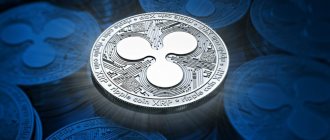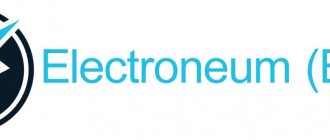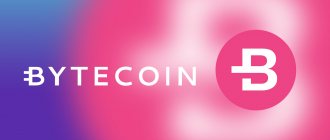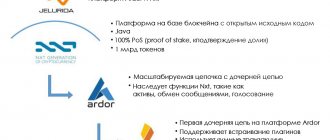- USD
- RUB
- BTC
*Data on the Percentage change in the rate and Trading Volume are indicated in the interval for the last 24 hours
Interest in the cryptocurrency industry is constantly growing. In this regard, the number of cryptocurrencies offered on the market is also increasing. Some of them are truly innovative products, while others are simply slightly modified copies of their predecessors.
One of the top cryptocurrencies at the moment is Ripple . The reason for the popularity of this cryptocurrency lies in the capabilities of the platform’s blockchain, which allows instant transactions in traditional currencies: dollars, euros, rubles, etc.
To operate, the system uses internal XRP tokens, which are traded on cryptocurrency exchanges. In connection with the above-mentioned opportunities, large banks and financial organizations are interested in the platform, which in turn helps to strengthen the XRP rate. In the 4 years since XRP was listed on exchanges, the Ripple rate has increased 40 times.
Performance
Where should we start? Anyone considering investing in Ripple should keep in mind that many new investors are eyeing this cryptocurrency. Whether you're new to or have experience investing in XRP, it's a good idea to review some of the numbers that set this currency apart from its many competitors in the cryptocurrency world.
The digital asset, which Ripple created in 2012, continues to outperform its competitors in the most important cryptocurrency categories. These performance metrics can scale up to the speeds of centralized payment databases such as VISA or PayPal. Numbers:
- Time of one transaction (full confirmation): 3.54 seconds
- Scalability: from 1,500 to 70,000+ transactions per second.
Liquidity statistics
At the end of 2020, and more recently at the beginning of January 2020, there was an explosion in the popularity of XRP, because... Many new crypto investors have discovered this cryptocurrency with unmatched performance. Due to this surge in demand, many new exchanges around the world are now offering this token as an alternative option to the traditional choice of Bitcoin as a means of payment. This demand is growing, and daily volume and liquidity are now measured in billions of dollars. Numbers:
- Number of currency pairs with XRP: 46
- 30-day Volume: $74.6 billion (~$2.5 billion per day)
- Market capitalization ranking: 3
Ripple forecast by month
Ripple’s forecast from experts for 2020 is gradually coming true: in terms of market capitalization, XRP has overtaken the Ethereum crypto coin and now occupies an honorable second place. The token rate has undergone many fluctuations and has been trading at $0.3-0.5 in recent months. Whether Ripple will grow in 2020 depends on a number of conditions. Positive dynamics are observed.
Such serious tools as analytical forecasts and analytics allow us to predict the likely picture of events in 2020 month by month, taking into account the current situation:
| Name of the month | Exchange rate in dollars |
| January | 4−4,2 |
| February | 4−4,5 |
| March | 4.5−5 |
| April | 5−5,2 |
| May | 5−5,5 |
| June | 4,5−5,5 |
| July | 4,5−5 |
| August | 5−5,5 |
| September | 5,5−6 |
| October | 5,5−6 |
| November | 6−6,5 |
| December | 6−6,5 |
The given forecast is approximate. Expert data was compiled according to an analysis of exchange rate dynamics over past years. In fact, indicators are prone to change, being influenced by factors: the activity of introducing Ripple into the banking sector, the position of government authorities, the success of the company.
Network costs
Ripple was specifically created with global sustainability in mind. The register can operate under maximum stress and is capable of supporting parabolic (i.e. quadratic) growth in the number of transactions. In order to ensure the required level of stability and speed when transmitting transactions on the network, various anti-spam mechanisms are built into the Ripple code, thanks to which the token can be safely used as an intermediate means of payment along with Bitcoin. Ripple contains code that will automatically adjust transaction fees during periods of peak network usage to prevent DDOS attacks or spam transactions. It also contains the necessary reserve amount for creating new wallets.
Figures (transaction costs):
- Minimum amount of currency required to activate the wallet (“reserve” volume): 20 XRP
- Open trustline for wallet: 5 XRP
- Order opening cost: 5 XRP
- Minimum transaction amount: 0.00001 XRP (10 drops)
Bank adoption of Ripple
One of the hotly debated topics among XRP fans and skeptics alike is how much of the demand for the coin will be driven by the adoption of the currency in the banking environment. At the beginning of Ripple's journey, the crypto community was largely skeptical of the idea, as no cryptocurrency had yet been accepted for use by traditional financial companies and banking regulators.
However, times are changing, and thanks to the obvious cost savings that Ripple provides, more and more banks and clients are considering adding xRapid to their toolkit. (xRapid is a Ripple payment system using XRP).
Numbers:
- Number of Ripple banking clients: 100+
- Number of clients deploying Ripple technologies commercially: 75+
- Number of (officially announced) clients using xRapid: 2
Ripple partnerships
The growth in popularity of this payment system can be associated with the fact that Ripple has entered into partnerships with the largest banks in the USA and other countries of the world. Among the financial institutions that use Ripple technology are: Bank of America, UniCredit Group, National Australia Bank, National Bank of Abu Dhabi and several dozen other large banks. The fact is, with the help of Ripple's technology, financial institutions can actually save millions of dollars a year in transaction costs. Therefore, every year more and more banks begin to experiment with distributed ledger technology.
Ripple studies banks
The project developers analyzed all the components that make up the cost of processing international payments across borders. They are familiar with previously used technologies, international data transfer standards, and the various methods that banks use to move assets around the world every day.
Using this knowledge, they created a set of software to achieve two goals:
Reducing transaction costs to almost zero Carrying out all transactions instantly, in real time Ripple software is progressive in nature; they don't force banks to use cryptocurrency. In fact, banks can achieve significant savings even without using XRP at all. Here's how the estimated cost savings work out for banks using this technology:
Numbers:
- 33% savings based on minimizing settlement delays, without using XRP
- 42% Cost Saving Using XRP in High Volatility
- 60% savings with XRP on low volatility
- For the first level, you should use a solution called “xCurrent” from Ripple. To achieve the second and third tier of savings, banks need to use “xRapid,” which uses XRP to maintain liquidity.
Wallet statistics
In October 2020, before the start of the SWELL conference, Ripple had about 500,000 activated wallets. Ripple's International Banking Conference, Central Bank Summit and subsequent client announcements led to a surge in investor interest in the currency as a speculative investment. Because of this, the number of active wallets today has exceeded one million. Keep in mind that in the XRP system, each wallet essentially acts as an anti-spam mechanism. This is achieved simply: you will have to deposit a certain amount of XRP into your account in order to simply activate the wallet. This amount is called “reserve” and cannot be withdrawn by the user. The concept is similar to the "minimum account balance" in the banking system. This factor means that the "importance" of each wallet in the system is clearly higher than in other networks - the possibility of creating multiple wallets still exists, but the likelihood of this is reduced if the rules of the network require the user to pay for each one. Here are the latest numbers:
- Number of XRP wallets: 1,044,512
- Percentage of XRP wallets holding more than 100,000 XRP: 1% (i.e. you need ~100K XRP to get into the “1% club” of the Ripple community)
How to buy and where to store XRP?
The process of purchasing Ripple is not much different from purchasing any other digital coin. First of all, you can buy XRP tokens on many cryptocurrency exchanges; you can see the quote table on the Neironix platform in the “exchanges” section on the “coins” page. If the process of purchasing XRP on exchanges is unacceptable to you for various reasons, then you have the opportunity to use one of the exchange sites. In addition, in order to buy Ripple you can send a direct payment to the coin holder. But this is a rather risky method, since the success of such an exchange will depend on the integrity of the seller. Ripple is a fairly popular cryptocurrency, so it can be stored in almost all variations of wallets: mobile, desktop, online, hardware, exchange, etc. Everyone chooses their own way to store their coins. You can find all the necessary information about the Ripple cryptocurrency on the website.
About company
We described how XRP differs from other cryptocurrencies. But probably one of the biggest reasons why many are investing in this cryptocurrency is the powerful team behind it. We will talk about this a little later. When new investors in the crypto world do their due diligence when choosing projects to invest in before making a purchase, they are faced with a plethora of different coins and crypto projects that have little more than a whitepaper and a name or two behind them. Blockchain technologies are now going through the same growth phase that the Internet experienced in the late nineties. Back then, almost any business with a “.com” in its name could attract fantastic dollar investments.
The situation for the crypto market became more complicated in mid-2020, when the US, China, and now even South Korea issued warnings and restrictions on ICOs and crypto exchanges. It has become quite obvious that many new projects owe their existence to a single reason - the desire of their owners to make money from easy money. Ripple does not belong to this dubious group of projects. From the very beginning, he was (and continues to be) one of the stars of Silicon Valley when it comes to blockchain technology. This is an established American business that was founded in 2012 and has managed to attract some of the most respected people in the world in this field to its list of investors. Ripple has methodically built its reputation based on hard work, listening to customer needs and responding to the demands of the banking industry. The ubiquitous XRP scenario is real and is based on solving real problems in the world for cross-border asset transfers. Ripple's goal is to make cross-border payments easier, and they are truly one of the leading companies in the world addressing this issue. Indeed, there is currently only one other organization that can position itself as an alternative to SWIFT, and that is Ripple.
Key figures related to Ripple:
- Years of work: 5+
- Number of employees: 150+
- Number of engineers/architects/developers: 90+
- Number of company offices: 7
- Number of company board members: 8
The main advantages of Ripple
The Ripple cryptocurrency platform was created as a direct competitor to the banking system and its technologies for transferring money between people. Blockchain technologies used by Ripple allow transactions to be carried out quickly, securely and anonymously. In addition, this method of exchanging funds is cheaper due to the absence of intermediaries. Cryptocurrencies have to prove their worth as a reliable payment instrument, but many people have already begun to invest in the crypto market, which has had a positive impact on the fact that the ripple rate has begun to actively grow.
The Ripple cryptocurrency is based on blockchain, but it has a number of differences from such popular cryptocurrencies as Ethereum, Litecoin, namecoin, nxt, peercoin and Bitcoin. Ripple is a universal payment platform with the goal of conquering the money transfer market. The creators of this currency initially aimed at the fact that they would eventually be able to displace the SWIFT system, offering users a safer, more reliable and faster way to transfer funds. The future of the ripple cryptocurrency will largely depend on how quickly the creators of this payment instrument can achieve their ultimate goal.
Related news:
- Liza - cryptocurrency forecast for 2020
- BitShares (BTS) Cryptocurrency Forecast for 2020
- Dashcoin (DSH) Cryptocurrency Forecast for 2020
- Time New Bank (TNB) Cryptocurrency Forecast for 2020
- HUSH cryptocurrency forecast for 2020
- Bitcoin Diamond cryptocurrency forecast for 2020...
There are a number of significant differences between conventional bank transfers and the Ripple cryptocurrency system, namely:
- When carrying out operations to transfer fiat currencies to other countries, the payment will pass through the hands of several intermediaries. In this case, all funds will be converted, which will lead to the need to pay additional fees. Such translations require a large amount of labor on the part of people and financial institutions, in addition, they are characterized by high cost and low speed of completion;
- At the same time, the ripple wallet allows you to reduce the number of operations and intermediaries when carrying out such transactions to a minimum. The primary currency will be immediately converted into XRP, and then transferred to the currency required by the recipient. The operation will be completed within a few seconds. When using this system, the distance and size of the transfer does not matter.
What's behind the numbers?
While the numbers and precise specifications may provide a quick introduction to cryptocurrency for many crypto investors, one of the most important factors inspiring XRP fans is the team behind Ripple, the small startup that created XRP in the first place. Ripple began its journey as a revolutionary idea since its inception and has evolved into a crypto network that many believe could eventually take the place of Bitcoin. One enthusiast who has invested in the currency had this to say about it: “Whenever you look at some aspect of XRP, think about the level of foresight required to plan ahead for global scalability without relying on wasteful mining to verify transactions. Although the entire Ripple project is open source, they decided to patent their consensus protocol because the team knew they had created something revolutionary. This is similar to Google patenting part of the search algorithm that the company developed.”
The company has the technology, but more importantly, it has the team that created the technology. Investors who believe in Ripple believe that Chris Larsen and David Schwartz will eventually be mentioned in textbooks on cryptocurrency and cryptography. The list goes on and this team is joined by other legends in the crypto and Forex industry such as Nick Bougalis, Warren Paul Anderson and Miguel Vias. New members of the team, who have become known as crypto celebrities, join almost every week - the list is too long to print here.
Without a doubt, statistics and numbers do not lie. However, to truly understand the potential of this currency, it is worth looking beyond the current state of the network to the future, no matter how impressive it is. XRP is considered by many to be on its way to becoming the number one cryptocurrency in the world. Thus, quite a few people believe that in the person of Ripple we have the most advanced Internet technology since the advent of the Internet itself, and these people are ready to trust the startup with their money because they associate the future with it.
Ripple rate
There is an opinion that the Ripple coin does not play the role of a competitor and a significant alternative to Bitcoin, but gradually, with the advent of news about the addition of technology to the work of large institutions, the Ripple rate jumps noticeably. After the February drawdown of the top tens, it is difficult to predict anything, including in Ripple, but the fact that the company is actively involving the banking sector for work is another plus. And, despite the legal proceedings between R3 and RippleLabs, which cannot share roles in the options contract, Ripple is normally staying afloat.
Studying the graphical course, I note that everything is according to the standard scenario - a jump - or a downward direction - “basement”, but the operability, not the use of blockchain as a base technology, supports the Ripple course. Since the day the coin entered the market, the Ripple rate has been greatly adjusted and today is almost the same as it was at the start.
Exchange rate to ruble
Analyzing the indicators of the ripple to ruble exchange rate, I will not surprise you if I say that, as in the case of other giants, the graph is trending downward. But, this is for now... Assessing the main changes over three months, we see a little more minus 100 rubles, when in a month this figure reached minus 20 rubles. The first business day of April (at the time of writing) again brought a slight drop in price, and today the coin is trading in the range of 27.1 - 27.0. This period can be considered suitable for those who have already decided on their further actions in relation to Ripple: buy and wait until market indicators increase, and one more thing is that there are more than 38 billion in circulation.
Exchange rate to dollar
After “disastrous Friday” at the beginning of February 2020, the Ripple exchange rate did not show any significant growing indicators, but data for the last six months suggests that we have positive changes, in particular +0.28 to the rate over the last 6 months. Therefore, it is now more profitable to buy a Ripple coin for a good old ruble than for a dollar. Let me note that the peak price of Ripple fell at the beginning of January (3 and a half dollars), and from that moment on, experts were afraid of a significant correction due to the possible introduction of a new large batch to the market. On average, after the February madness, the Ripple exchange rate to the dollar remains stable in the range of $0.48-0.5 per coin, and the total change in the exchange rate for the year is 2.087.84%.
Battle of the Twins
It's worth noting that despite Ripple's stellar journey, its path to the top will not be a cakewalk. And it’s not even a matter of resistance from the “giants” of the crypto market – Bitcoin and Ethereum, each of which has its own plan to capture the global market. The threat to Ripple may come from its “brother” Stellar (XLM). Despite the more than tenfold difference in capitalization in favor of the former, Stellar nevertheless remains in many ways a “dark horse” and justifies its title “Ripple without flaws” (the main problem with XRP is its centralization and, therefore, the possibility of rate manipulation and other abuses ). With largely the same marketing models, except that Stellar is completely decentralized while Ripple is concentrated in a few power points, the two cryptocurrencies will not be able to separate on their way to the top and will inevitably meet in a brutal battle. You can read more about Stellar and its differences from Ripple in a separate article .
how and where it is most profitable to buy Ripple for rubles, dollars and hryvnia by reading the corresponding article.
get the best wallet for XRP by reading a separate article.










